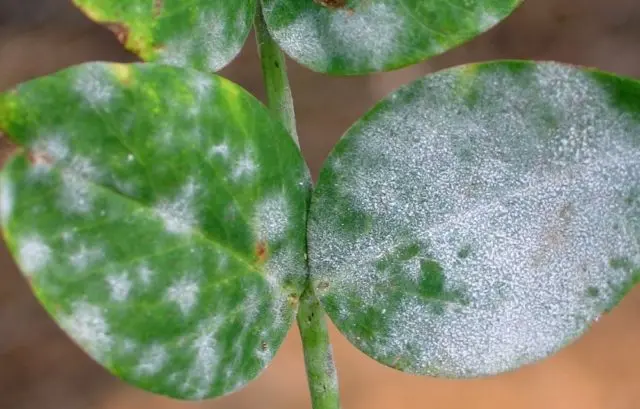Contents
Siberian buzulnik is a kind of innovation in landscape design. The plant has not only juicy yellow inflorescences, but also medicinal properties. Novice gardeners will appreciate all the benefits of the buzulnik: the culture will generously bestow its beauty on those who provide it with minimal care.

Siberian buzulnik can become a garden decoration even without other vegetation around.
Description of the Siberian buzulnik
Siberian buzulnik (lat. Ligularia sibirica) belongs to the Astrov family. This is a powerful and unpretentious perennial in care, which can grow without a transplant for up to 15 years. The stem is strong, ribbed. The basal leaves of the Siberian buzulnik are large, heart-shaped, the base with a deep cut. The culture reaches a height of 0,3 m to 1,5 m. The leaves on the stem are small, lanceolate, covered with winged petioles of brown-red color.
Bright yellow flowers of the Siberian buzulnik are grouped into lush oblong inflorescences up to 60 cm long. Each flower has a single-row wrapper, linear petals. Flowering lasts from early July to late September. After that, fruits appear – oval-shaped seeds with a creamy crest.
The Siberian buzulnik prefers moisture-saturated soil, therefore, in nature, it lives in the coastal zones of rivers and reservoirs, in coniferous-small-leaved forests, and in swampy areas. Its main places are the Baltic States, Belarus, Central Europe, the east of Central Asia. In Our Country, it is distributed mainly in Siberia. Due to the massive disturbance of the habitat of the Siberian buzulnik (drainage of swamps, deforestation, changes in the hydrological regime of the area), in several areas it is listed in the Red Book.
The Siberian buzulnik has several subspecies. All of them, although they have medicinal properties, are used mainly in landscape design. Gardeners have only recently discovered the virtues of the buzulnik, so the wide popularity of the culture is yet to come.
Application in landscape design
Siberian buzulnik is a bright accent against the background of low-growing trees and shrubs. It can be not only the centerpiece of a landscape composition, but will also become an excellent participant in a group planting, as a hedge. The culture loves water, therefore it is a frequent decoration of a garden decorative pond or an alpine slide. Bright yellow clusters will be reflected in the water surface, which will enhance the visual effect.
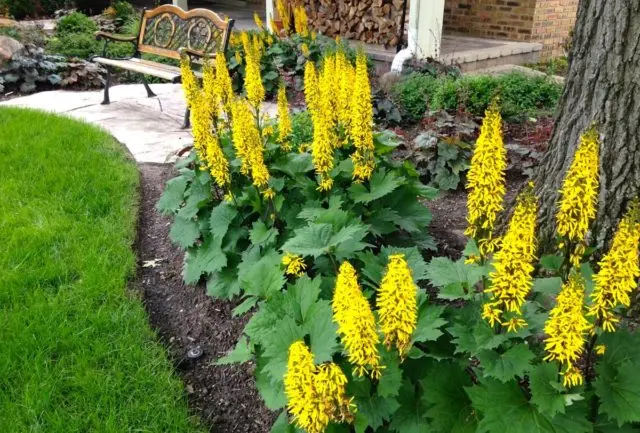
Penumbra near a wide tree solves 2 issues at once: creates partial shade and protects from drafts
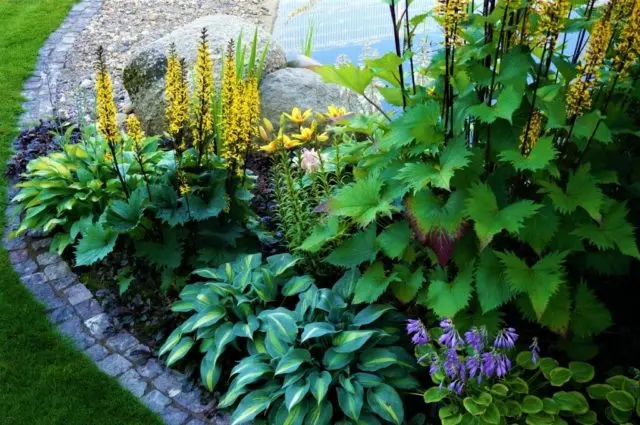
The plot looks advantageous if you plant a Siberian buzulnik next to flowers of blue or blue tones
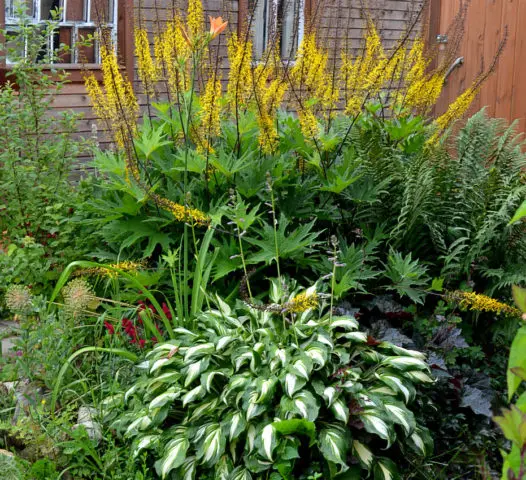
The original will be a multi-level composition, in which next to the Siberian buzulnik there will be a lower bush or flowers
Features of reproduction
The Siberian buzulnik is propagated by seed or by dividing the bush. The second method is preferable because it is simpler and takes less time.
Seed propagation occurs as follows:
- It is necessary to collect the seeds from the bush, dry them.
- Landing is carried out in autumn or early spring, immediately in open ground, but in a separate place. Seeds should be planted in a hole to a depth of 2 cm. Seedlings will sprout in the spring.
- After they are strengthened, the plant can be transferred to a permanent habitat. Flowering will occur 3-4 years after planting.
Reproduction of the Siberian buzulnik by dividing the rhizome is easier and more reliable. For this you need:
- Dig up a bush with a root, clean it from the ground.
- With garden shears or a sharp knife, carefully cut the rhizome into 2-3 parts. It is important that each had at least 1 live kidney.
- Immediately plant a seedling in a place of permanent residence.

The homeland of the Siberian buzulnik is the South-West of China, where its main population grows.
Planting and care
Since the Siberian buzulnik is an unpretentious plant, it withstands frosts down to -25 ° C. Although the plant can live for a long time without a transplant, after 5-7 years its roots grow too much, dangerously approaching the surface of the earth. Therefore, it is desirable to share it.
The stems of the culture are quite high, so they can break in strong winds. To prevent this, gardeners are advised to choose a place for plants near a fence or building. There are no special requirements for the soil, the main thing is the saturation with minerals and water.
Recommended dates
Planting a divided bush occurs in early spring, when living buds become visible. Seeds can be planted both in spring and autumn. In the latter case, they will go through the process of natural stratification, i.e. hardening. This will make the Siberian buzulnik stronger and more stable.
Site selection and soil preparation
Siberian buzulnik loves soil saturated with moisture and useful minerals. It is also worth considering that in an open sunny area, the plant will feel good only with abundant watering. The best place is partial shade, without drafts.
Landing algorithm
The landing of the Siberian buzulnik is carried out as follows:
- Dig a hole measuring 40×40 cm.
- Mix the extracted soil with humus and mineral fertilizers.
- On the separated seedling, rinse the roots with running water, treat the cut site with wood ash.
- Place a little humus, wood ash and superphosphate at the bottom of the hole, pour abundantly.
- Install the seedling, fill it with the prepared nutrient mixture. Stomp a little.
- Plentifully water the bush with rainwater.
Watering and fertilizing schedule
Siberian buzulnik loves well-fertilized soil. If humus was added to the hole during transplantation, then nothing more is required in the first year. In the future, the buzulnik should be fertilized once a year, before flowering, in well-moistened soil. Top dressing should be carried out with a solution of mullein (for 1 liter of fertilizer – 1 liters of water).
The sunnier the area, the more moisture the buzulnik needs. Proximity to water bodies should also be taken into account. Watering is carried out 3-4 times a week, in the morning or in the evening, after the decline in solar activity. In the dry season, the Siberian buzulnik requires additional leaf spraying.
Loosening and mulching
The soil around the Siberian buzulnik must be periodically loosened, thereby saturating it with oxygen. Too deep is not necessary so as not to damage the rhizome.
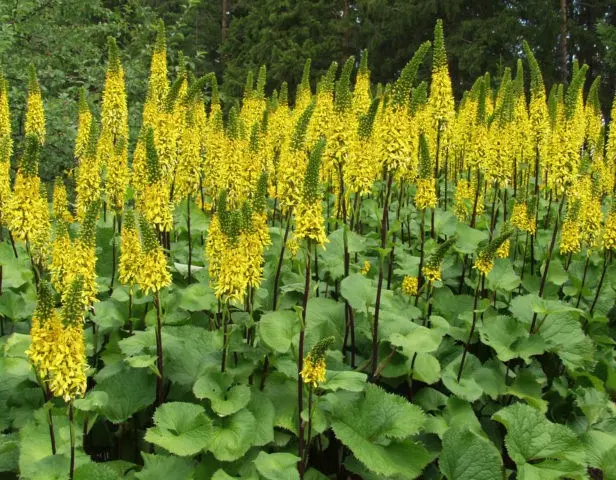
Loosening is also required so that water penetrates deeper into the ground.
Mulching will help prevent rapid evaporation of moisture from the soil. As mulch, you can use sawdust, dry grass, mowed hay.
Preparation for winter
Siberian buzulnik perfectly tolerates wintering. But even in cold weather, the plant needs precipitation, and if there is none, it may die. Therefore, it is necessary to cut the shoots up to 1-2 cm, mulch the soil around. Additionally, you can cover the buzulnik with spruce branches, humus, fallen leaves or other covering material.
Diseases and pests
The Siberian buzulnik has developed strong immunity against diseases and pests. Most often, damage is caused by:
- Mučnistaâ rosa. The first sign of the disease are spots on the leaves. They are easy to wash off, but this will not protect against their further appearance. Further, the lower leaves become covered with brown spots, gradually the disease passes to the upper part of the plant. The affected areas dry and die, which leads to the death of the culture. You can prevent the disease by preventive spraying with sulfur or whey (three times a season). Top dressing with phosphorus-potassium fertilizers during the flowering period will increase the plant’s immunity to diseases. In case of damage, fungicidal preparations are used, according to the instructions.

Warm, humid weather favors the growth of harmful powdery mildew bacteria.
- Slugs and snails. Pests feed on shoots and foliage, so their appearance will be noticeable immediately. So that they do not climb onto the Siberian buzulnik, it should be fenced off (create an obstacle). Gravel, sand, nutshells, superphosphate granules, even pepper and tobacco dust will do. In addition, you can place water bottles in the trenches around the plants. You can deal with individuals that have already appeared by hand-picking or spraying with Thunderstorm, Meta preparations.

Slugs prefer young, large and soft leaves rich in nutrients.
Conclusion
Siberian buzulnik is a great alternative for decorating a garden. For no apparent reason, this culture was neglected for a long time. But thanks to its spectacular appearance and unpretentiousness, the Siberian buzulnik is quickly gaining popularity among both professional garden decorators and ordinary people.










